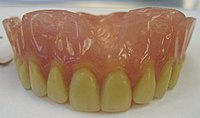
Photo from wikipedia
PURPOSE Incomplete polymerisation processes produce several leachable substances. The aim of this work was to review, through existing research and published literature, the genotoxic effect of residual monomers of polymers… Click to show full abstract
PURPOSE Incomplete polymerisation processes produce several leachable substances. The aim of this work was to review, through existing research and published literature, the genotoxic effect of residual monomers of polymers used in restorative dentistry. MATERIALS AND METHODS The selection of published studies was performed on six databases from January 2000 to June 2020. The keywords used were: 'genotoxicity' or 'DNA damage' and 'dental resin' or 'methacrylates' or 'residual monomers'. The selection was carried out according to the parameters and guidelines of the Preferred Reporting Items for Systematic Review and Metanalyses (PRISMA) and was based on patient, intervention, comparison, and outcome (PICO). The inclusion criteria were: in vitro and in vivo studies published in English that evaluated genotoxicity for residual monomers leached from polymers related to restorative dentistry. Case reports and review articles were excluded. RESULTS Twenty-seven studies met the eligibility criteria. Two categories were constructed based on the experimental design, in vivo and in vitro reports. For the in vitro research, two main methods of assessing DNA damage were reported in selected studies: micronucleus (MN) counting and alkaline comet assay. For in vivo reports, the main method for assessing genotoxic damage was MN counting. CONCLUSION From the electronic search, structured data extraction, and analysis by different independent reviewers, results from the present systematic review allow us to conclude that DNA damage is induced by monomers/co-monomers (triethylene glycol dimethacrylate, bisphenol-A-glycidyl methacrylate, urethane dimethacrylate, and 2-hydroxyethyl methacrylate) that are used in restorative dentistry. This systematic review highlights the need for more research on the use of monomers/co-monomers to properly assess clinical biocompatibility.
Journal Title: Oral health & preventive dentistry
Year Published: 2021
Link to full text (if available)
Share on Social Media: Sign Up to like & get
recommendations!